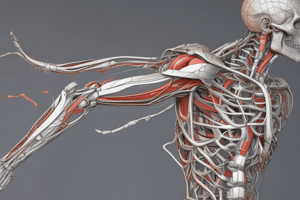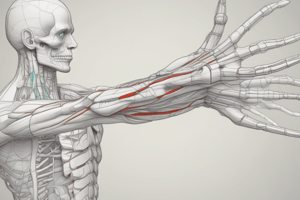Podcast
Questions and Answers
What is the primary function of the deltoid muscle?
What is the primary function of the deltoid muscle?
- Shoulder abduction (correct)
- Flexion of the wrist
- Stabilization of the shoulder joint
- Extension of the elbow
Which bones comprise the forearm?
Which bones comprise the forearm?
- Metacarpals and phalanges
- Radius and ulna (correct)
- Clavicle and scapula
- Humerus and radius
What type of joint is the elbow joint?
What type of joint is the elbow joint?
- Ball-and-socket joint
- Saddle joint
- Pivot joint
- Hinge joint (correct)
Which nerve primarily innervates the forearm flexors?
Which nerve primarily innervates the forearm flexors?
How many total phalanges are present in one hand?
How many total phalanges are present in one hand?
What is the main function of the triceps brachii muscle?
What is the main function of the triceps brachii muscle?
Which arterial vessel continues from the subclavian artery in the arm?
Which arterial vessel continues from the subclavian artery in the arm?
Which muscles are responsible for moving the little finger?
Which muscles are responsible for moving the little finger?
What surrounds muscles and compartments in the upper limb?
What surrounds muscles and compartments in the upper limb?
Which of these nerves innervates the posterior arm and forearm?
Which of these nerves innervates the posterior arm and forearm?
Flashcards are hidden until you start studying
Study Notes
Anatomy of the Upper Limb
General Overview
- The upper limb consists of the shoulder girdle, arm, forearm, and hand.
- Functionally divided into bones, muscles, blood vessels, nerves, and connective tissues.
Bones
-
Shoulder Girdle
- Clavicle (collarbone)
- Scapula (shoulder blade)
-
Arm
- Humerus (upper arm bone)
-
Forearm
- Radius (lateral bone, thumb side)
- Ulna (medial bone, pinky side)
-
Hand
- Carpals (wrist bones, 8 total)
- Metacarpals (hand bones, 5 total)
- Phalanges (finger bones, 14 total: 3 per finger, 2 per thumb)
Joints
- Shoulder Joint: Ball-and-socket joint allowing a wide range of motion.
- Elbow Joint: Hinge joint enabling flexion and extension.
- Wrist Joint: Complex joint allowing flexion, extension, and limited rotation.
Muscles
-
Shoulder Muscles
- Deltoid: Shoulder abduction
- Rotator cuff muscles: Stabilization of the shoulder joint.
-
Arm Muscles
- Biceps brachii: Flexion of the elbow and supination of the forearm.
- Triceps brachii: Extension of the elbow.
-
Forearm Muscles
- Flexors: Flexion of the wrist and fingers (anterior compartment).
- Extensors: Extension of the wrist and fingers (posterior compartment).
-
Hand Muscles
- Thenar muscles: Move the thumb.
- Hypothenar muscles: Move the little finger.
- Interossei: Abduct and adduct fingers.
Blood Supply
- Subclavian Artery: Supplies blood to the upper limb.
- Brachial Artery: Continuation of subclavian in the arm.
- Radial and Ulnar Arteries: Supply the forearm and hand.
Nerves
- Brachial Plexus: Network of nerves supplying the upper limb.
- Major branches include:
- Musculocutaneous nerve: Innervates anterior arm.
- Median nerve: Innervates forearm flexors and hand.
- Ulnar nerve: Innervates intrinsic hand muscles.
- Radial nerve: Innervates posterior arm and forearm.
- Major branches include:
Connective Tissue
- Fascia: Surrounds muscles and compartments.
- Tendons: Connect muscles to bones.
- Ligaments: Connect bones to other bones at joints.
Functional Considerations
- The upper limb allows for a wide range of movements and precise manipulation, essential for daily activities and tool use.
- Importance of stability and mobility in joint function, especially in the shoulder and wrist.
General Overview
- The upper limb is divided into four main sections: shoulder girdle, arm, forearm, and hand.
- Composed of bones, muscles, blood vessels, nerves, and connective tissues for various functions.
Bones
- Shoulder Girdle: Comprises the clavicle (collarbone) and scapula (shoulder blade).
- Arm: Contains the humerus, the single bone of the upper arm.
- Forearm: Features two bones:
- Radius: Positioned laterally, associated with the thumb side.
- Ulna: Positioned medially, associated with the pinky side.
- Hand:
- Carpals: Eight wrist bones forming the wrist structure.
- Metacarpals: Five bones constituting the framework of the hand.
- Phalanges: Fourteen finger bones (three per finger, two per thumb).
Joints
- Shoulder Joint: A ball-and-socket configuration promoting extensive movement.
- Elbow Joint: Functions as a hinge joint, permitting flexion and extension.
- Wrist Joint: Complex structure allowing for flexion, extension, and some rotational movement.
Muscles
- Shoulder Muscles:
- Deltoid: Primarily responsible for shoulder abduction.
- Rotator Cuff Muscles: Essential for shoulder stabilization during movement.
- Arm Muscles:
- Biceps Brachii: Facilitates elbow flexion and forearm supination.
- Triceps Brachii: Responsible for elbow extension.
- Forearm Muscles:
- Flexors: Control wrist and finger flexion (located in the anterior compartment).
- Extensors: Manage wrist and finger extension (located in the posterior compartment).
- Hand Muscles:
- Thenar Muscles: Focus on thumb movement and functionality.
- Hypothenar Muscles: Specialize in movements of the little finger.
- Interossei: Aid in finger abduction and adduction.
Blood Supply
- Subclavian Artery: The primary artery providing blood to the entire upper limb.
- Brachial Artery: Continuation from the subclavian artery, supplying the arm.
- Radial and Ulnar Arteries: Supply regions of the forearm and hand, ensuring adequate blood flow.
Nerves
- Brachial Plexus: A network that supplies sensory and motor functions to the upper limb.
- Major Nerve Branches:
- Musculocutaneous Nerve: Primarily innervates the anterior arm muscles.
- Median Nerve: Innervates forearm flexors and several hand muscles.
- Ulnar Nerve: Responsible for the innervation of intrinsic hand muscles.
- Radial Nerve: Innervates muscles of the posterior arm and forearm.
Connective Tissue
- Fascia: Encloses muscles and delineates compartments.
- Tendons: Connect muscles to bones, facilitating movement.
- Ligaments: Connect bones to each other at joints, providing stability.
Functional Considerations
- The upper limb's design allows for diverse movements and precise manipulations crucial for daily tasks and tool usage.
- Stability and mobility are vital in joint function, particularly within the shoulder and wrist, enabling effective movement and control.
Studying That Suits You
Use AI to generate personalized quizzes and flashcards to suit your learning preferences.





